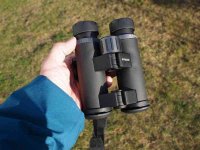For me the best in that regard has to be the little bushnell elite custom 7x26..very high contrast in all light situations...Pentax ED 8x32 is good too..I have a Kenko 8x32( ,forgot the model,i think is a clone of the sightron BS II),that look a lot that this Minox you are talking about ,and does also pretty good controlling glare.....now,,one thing a binocular can not do is to show an image without glare,IF There is glare in the atmosphere..sometimes ,because of the angle of the sun, the geography or the air conditions and quality ,light disperses in weird ways..in those conditions at 1x the view could seem more or less fine for observation,but when looking through bins or scope we notice glare or fog,and we worry our optics are not very contrasty..What we are actually doing is magnifying less than perfect light conditions.This is good to remember to avoid constant frustration ..and then is light reflections from the eyepiece!,!!
Zeiss Fl controls glare from the objetive real nicely but its flushed ocular lens is prone to mirror...







